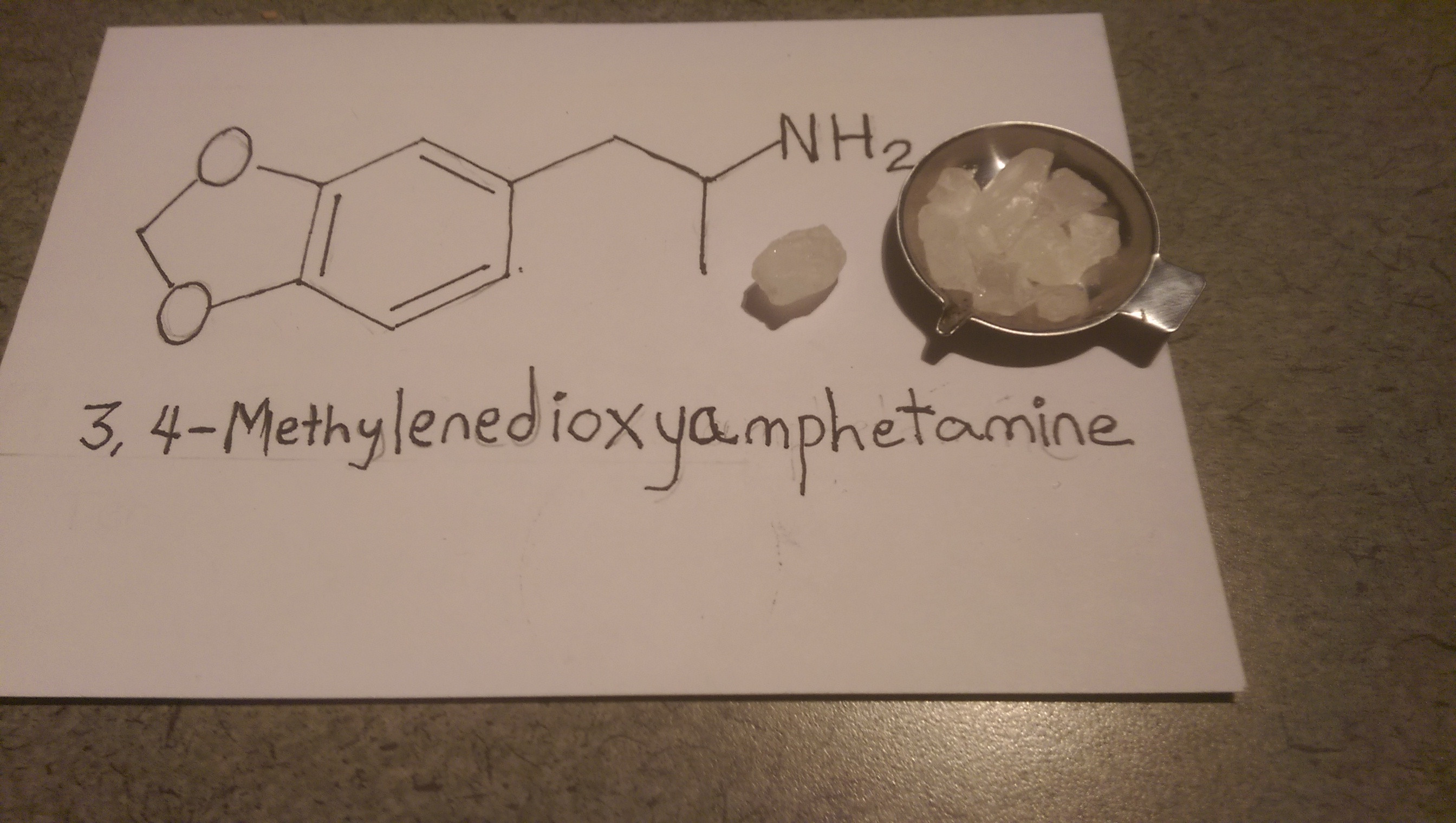MDA

MDA (Methylenedioxyamphetamine) is an popular drug of the phenethylamine and amphetamine class knownthat is mainly used as a recreational drug, an entheogen, and a tool in use to supplement various types of practices for transcendence, including in meditation, psychonautics, and as an agent in psychedelic psychotherapy.
It most frequently comes in tablet form, although it is also found in capsules or as powder. MDA is also known as "sass" or "sassafras"and several other names.
History
MDA was first synthesized by G. Mannish and W. Jacobson in 1910.
It was first ingested in July 1930 by Gordon Alles who then licensed the drug to Smith Kline and French. MDA was first used in animal tests in 1939, and human trials began in 1941 in the exploration of possible therapies for Parkinson's disease. From 1949 to 1957, more than 500 human subjects were given MDA in an investigation of its potential use as an antidepressant and/or anorectic by Smith, Kline & French.
The United States Army also experimented with the drug, code named EA-1298, while working to develop a truth drug or incapacitating agent. One human subject died in January 1953 after being intravenously injected with 450 mg of the drug.
MDA was patented as a cough suppressant by H. D. Brown in 1958, as an ataractic by Smith, Kline & French in 1960, and as an anorectic under the trade name “Amphedoxamine” in 1961. Several researchers, including Claudio Naranjo and Richard Yensen, have explored MDA in the field of psychotherapy.
MDA began to appear on the recreational drug scene around 1963 to 1964. It was then inexpensive and readily available as a research chemical from several scientific supply houses. Although now illegal, MDA continues to be bought, sold, and used as a recreational 'love drug', due to its enhancement of empathy.
Dosage
{{#tdose: mda }}
Duration
| Onset | 20-90 minutes |
| Peak | 2-4 hours |
| Total | 4-8 hours |
| After-effects | 3-24 hours |
Effects
Postive
- Extreme mood lift
- Increased willingness to communicate
- Increase in energy (stimulation)
- Ego softening
- Feelings of comfort, belonging, and closeness to others
- Feelings of love and empathy
- Forgiveness
- Increased awareness & appreciation of music
- Increased awareness of senses (taste, smell, touch, hearing, vision)
- Profound life-changing spiritual experiences
- Neurotically based fear dissolution
- Sensations bright and intense
- Urge to hug and kiss people
Neutral
- Decreased appetite
- Visual distortion
- Rapid, involuntary eye jiggling (nystagmus)
- Mild visual hallucinations
- Moderately increased heart rate and blood pressure (increases with dose)
- Restlessness, nervousness, shivering
- Change in body temperature regulation
- Strong desire to do or want more when coming down
Negative
- Inappropriate and/or unintended emotional bonding
- Tendency to say things you might feel uncomfortable about later
- Mild to extreme jaw clenching (trisma), tongue and cheek chewing, and teeth grinding (bruxia)
- Difficulty concentrating & problems with activities requiring linear focus
- Short-term memory scramble or loss & confusion
- Muscle tension
- Erectile disfunction and difficulty reaching orgasm
- Increase in body temperature, hyperthermia, dehydration (drink water)
- Hyponatremia (don't drink too much water)
- Nausea and vomiting
- Headaches, dizziness, loss of balance, and vertigo
- Post-trip Crash - unpleasantly harsh comedown from the peak effect
- Hangover the next day, lasting days to weeks
- Mild depression and fatigue for up to a week
- Severe depression and/or fatigue (uncommon)
- Possible strong urge to repeat the experience, though not physically addictive
- Possible psychological crisis requiring hospitalization (psychotic episodes, severe panic attacks, etc) (rare)
- Possible liver toxicity (rare)
- Neurotoxicity
- Small risk of death. Assuming similar risk to MDMA, approximately 2 per 100,000 users have extreme negative reactions resulting in death (rare)
Hangover
Many users report feeling extremely drained the day after MD(M)A use. This 'day after' effect means for many MD(M)A users that they need to plan 2 days for the experience: one for the peak experience and one recovery day, with very little planned. Many users also experience some level of post-MD(M)A depression, often starting on the second day after the experience and lasting for up to 5 days. A small percentage of users report depressive symptoms for weeks afterwards. Alternately, some users report feeling better than normal for a week or so after taking MD(M)A . The negative after-effects of taking MDMA appear to be worse with higher frequencies of use, higher dosages, and perhaps total lifetime usage.
Harm Reduction
MDA rapidly builds tolerance, depletes serotonin and compounds neurotoxicity issues. Look for other drugs and avoid using MDA more than once every few months.
Ecstasy tablets are notoriously impure, often containing chemicals other than MDA. Check out EcstasyData and Pill Reports for pill testing results. Buy a Test Kit!
See Psychedelic Harm Reduction for general information.
Interactions
MDA can cause Serotonin Syndrome when combined with MAOIs. Refer to Drug combinations for more information.
SSRIs and SNRIs block most effects of MD(M)A.
Chemistry and Pharmacology
Chemical name: (R) 1-(benzo[1,3]dioxol-5-yl)propan-2-amine
Take a look at MDMA Chemistry and Pharmacology. MDA is around five times as neurotoxic as MDMA and should not be used frequently.
Legal status
MDA is legally controlled in most of the world under the UN Convention on Psychotropic Substances and other international agreements, although exceptions exist for research and limited medical use. In general, the unlicensed use, sale or manufacture of MDA are all criminal offences.
Links
A step-by-step guide to reducing MD(M)A neurotoxicity